STAFF
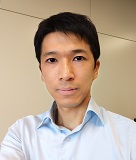
Dr. Hiroki MATSUO
- Research Fields
- Ferroelectrics, Lattice defects, Domain engineering, Pulsed-laser deposition
- Website
- YouTube
- Featured Article
- matsuo_h[at]cs.kumamoto-u.ac.jp
*Please replace "[at]" with @.
Research interest
光センシングに向けた強誘電体材料
(「MEMSセンシング&ネットワークシステム展 2025」展示資料)
Ferroelectric materials have spontaneous electric polarization arising from a non-centrosymmetric crystal structure that can reversed by application of external electric field. Because of their characteristic polar structure, ferroelectric materials exhibit various functions such as piezoelectricity, pyroelectricity, electro-optic effect and anomalous photovoltaic effect, etc. Current research interest is the exploration of novel functions of the ferroelectric materials based on the following materials design strategies.
1.Ferroelectric artificial superlattice
A superlattice thin film has a periodic structure composed of thin layers of two or more materials. Because of an interfacial effect and a strong interaction between the layers, the superlattice sometimes exhibits unexpected property that is not predictable from the bulk properties of the constituting materials. The study aims to develop a ferroelectric thin-film capacitor that exhibits quite high energy density by exploiting the characteristic feature of the superlattice structure. For the fabrication of the ferroelectric superlattice, pulsed-laser deposition method with a reflection high energy electron diffraction system is used.
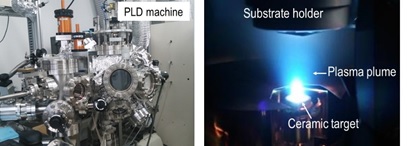
2.Ferroelectric photovoltaic effect
Ferroelectric materials exhibit characteristic photovoltaic responses owing to their polar crystal structure. While photovoltage generated by the conventional p-n junction of semiconductors is limited by bandgap energy of the materials, ferroelectric materials exhibit a high photovoltage exceeding the bandgap energy of them. We aim to enhance the photovoltaic response of the ferroelectric materials especially under visible light irradiation by chemical doping and by controlling ferroelectric domain structures.
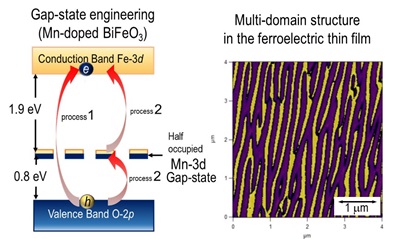
3.Interaction between ferroelectric polarization and lattice defects
Charged lattice defects in the ferroelectric crystals strongly interact with the ferroelectric polarization through electrostatic and mechanical effects. The interaction enables control of the ferroelectric property by designing species, concentration, and distribution of the defects in the crystals. The goal of this study is to establish an effective approach to obtain desired ferroelectric properties by defect engineering.
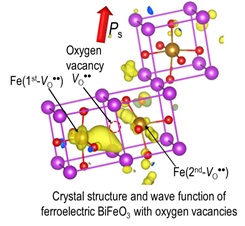
Research Activities
Topic
Attended the award ceremony of "Kumamoto University Research Achievement Award FY2024 (熊本大学研究業績表彰)" on November 25, 2024.
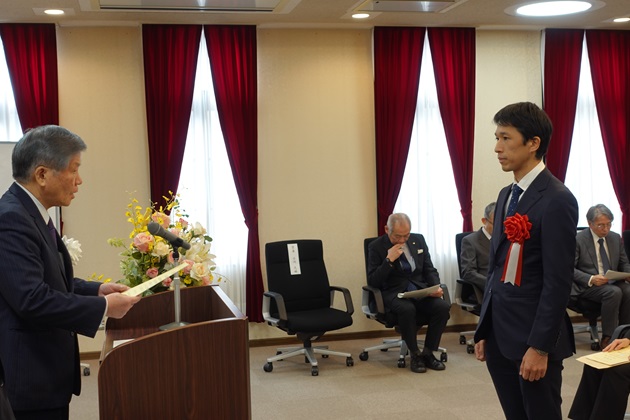
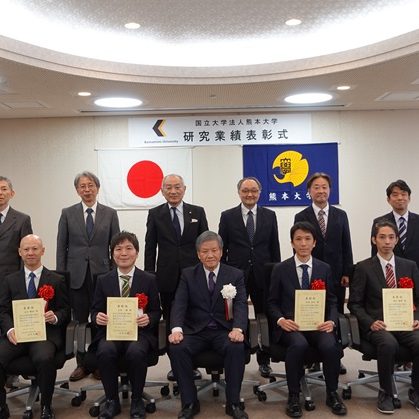
Presentations
- Yuji Noguchi and Hiroki Matsuo
“Design of ferroelectric materials for energy storage applications utilizing interaction between defects and polarization”
Annual Meeting 2023 of the Ceramic Society of Japan, Mar. 2023, Yokohama. - (Invited) Hiroki Matsuo
The 77th Ceramic Society of Japan Awards for Advancements in Ceramic Science and Technology
“Development of Photovoltaic Functions in Perovskite-type Ferroelectric Materials”
Annual Meeting 2023 of the Ceramic Society of Japan, Mar. 2023, Yokohama. - Tomoki Sato, Hiroki Matsuo, and Yuji Noguchi
“Photovoltaic effect of Cu-doped LiNbO3 single crystals under visible light”
42nd Meeting on Electronic Materials, Nov. 2022, Yokohama. - Shun Fukushima, Hiroki Matsuo, and Yuji Noguchi
“Defect engineering for ferroelectric BaTiO3 for energy storage ceramic capacitors”
42nd Meeting on Electronic Materials, Nov. 2022, Yokohama. - Hiroki Matsuo and Yuji Noguchi
“Domain-engineered BiFeO3-base ferroelectric with high-photocurrent anisotropy for visible-light polarization detection”
13th Korea-Japan Conference on Ferroelectrics (KJC-FE13), Sep. 2022, Busan (Virtual) - Hiroki Matsuo and Yuji Noguchi
“Ferroelectric Photovoltaic Effect in BiFeO3-based solid-solution thin films with nanodomain structures”
35th Fall Meeting of the Ceramic Society of Japan, Sep. 2022, Tokushima (Virtual). - Seiyu Aso, Hiroki Matsuo, and Yuji Noguchi
“Fabrication and characterization of defect-engineered NaNbO3-based antiferroelectric ceramics”
35th Fall Meeting of the Ceramic Society of Japan, Sep. 2022, Tokushima (Virtual). - Hiroki Matsuo and Yuji Noguchi
“Enhanced photovoltaic effects in ferroelectric thin films with nanodomains”
15th International Symposium on Ferroic Domains & Micro- to Nano-scopic Structures (ISFD-15), Aug. 2022, Yamanashi.
Achievement
Publications
- 2024
- 2023
-
- Design and Fabrication of Protonic Ceramic Fuel Cells Based on BaZr0.8Y0.2O3−δ |BaZr0.1Ce0.7Y0.1Yb0.1O3−δ Bilayer Electrolyte
- Domain-wall photovoltaic effect in ferroelectric perovskite oxides
- Impact of Mn doping on the ferroelectric photovoltaic effect in multidomain BiFeO3 thin films under above-bandgap illumination
- Reversible electric-field-induced phase transition in Ca-modified NaNbO3 perovskites for energy storage applications
- 2022
-
- Origin of Ferroelectricity in BiFeO3-Based Solid Solutions
- Utilizing ferrorestorable polarization in energy storage-ceramic capacitors
- High Photocurrent Anisotropy in Domain-Engineered Ferroelectrics for Visible-Light Polarization Detection
- High-quality ferroelectric Bi0.5K0.5TiO3‒BiFeO3 solid-solution single crystals grown under high-pressure oxygen atmosphere
- Ferroelectric polarization of tetragonal BiFeO3—an approach from DFT calculations for BiFeO3–BaTiO3 superlattices—
- 2021
Grants
Murata Science and Education Foundation (村田学術振興・教育財団) “Development of organic-inorganic hybrid ferroelectric thin films exhibiting the bulk photovoltaic effect under visible light illumination”, September 2024‒August 2025.
Grant-in-Aid for Transformative Research Areas (A), (The Japan Society for the Promotion of Science), "Control of Defect Dipoles for Designing Hyper-Ordered Structure in Ferroelectric Perovskite Oxides (ペロブスカイト型強誘電体における欠陥双極子の制御と超秩序構造設計)", April 2023-March 2025
Grant-in-Aid for Early-Career Scientists (The Japan Society for the Promotion of Science), "強誘電体超格子薄膜を用いた次世代蓄電デバイスの創製", April 2022-March 2023
The Asahi Glass Foundation Research Encouragement Grants FY2022, 次世代蓄電デバイスに向けた新規欠陥双極子誘起強誘電体の創製, April 2022-March, 2023
Awards
The 8th International Workshop on Relaxor Ferroelectrics (IWRF 2024) Best Poster Award
Kotaro Saito, Hiroki Matsuo, Yuji Noguchi* (Kumamoto Univ.), Hiroshi Nakajima, Shigeo Mori (Osaka Metropolitan Univ.), Zuo-Guang Ye (Simon Fraser Univ.)
“Relaxor behavior and energy storage properties of (Bi1/2K1/2)TiO3-(Bi1/2Li1/2)TiO3 solid solution ceramics” Oct. 28, 2024, Xi'an (China)Kumamoto University Research Achievement Award FY2024 (令和6年度国立大学法人熊本大学研究業績表彰), Nov. 25, 2024
→ NEWSBest Young Researcher Presentation Award, The 40th Meeting on Ferroelectric Materials and Their Applications (FMA40)
“Polarization Detection Properties of BiFeO3-based Ferroelectric Thin Films in Visible Light Region” May. 2023
→NEWSThe 77th CerSJ Awards for advancements in ceramic science and technology (2022), 「ペロブスカイト型強誘電体における光電変換機能の開拓」”Development of Photovoltaic Functions in Perovskite-type Ferroelectric Materials”
The Ceramic Society of Japan (CerSJ)
*Approved on November 29, 2022(→ NEWS), and received on June 7, 2023(→ NEWS)Excellent Presentation Award, "Domain-engineered BiFeO3-based ferroelectrics with high-photocurrent anisotropy for visible-light polarization detection"
The 13th Korea-Japan Conference on Ferroelectrics (KJC-FE 13), Sep. 25-28, 2022
→ NEWSThe 18th JACG Best Presentation Awards, “Gap-State Engineering for Ferroelectric Photovoltaic Effect in BiFeO3 Epitaxial Thin Film”
Japanese Association for Crystal Growth (JACG). Dec. 13 2021
→ NEWS
- STAFF
-
- Wei XU
- Shinichiro Sawa
- Tetsuya KIDA
- Armando T. QUITAIN
- Junhua WANG
- Yoshihiro SEKINE
- Akira UEDA
- Yusuke INOMATA
- Muhammad Sohail AHMAD
- Jonas Karl N. AGUTAYA
- Nobleson KUNJAPPY
- Prafulla Bahadur MALLA
- Mohammad Atiqur RAHMAN
- Reetu Rani
- Kei TODA
- Tomoyasu MANI
- Agus Pulung SASMITO
- Tung Thanh TRAN
- Dario ZAPPA
- Daniel P. ZITTERBART
- Mitsuhiro AIDA
- U Rajendra ACHARYA
- Dmitri Aleks MOLODOV
- László PUSZTAI
- Yufeng ZHENG
- Gaochuang CAI
- Masahiko FURUTANI
- Hiroki MATSUO
- Zhongyue ZHANG
- Adam Karl SCHWARTZKOPFF
- Takashi ISHIDA
- Takumi HIGAKI
- Takahiro HOSONO
- Kei ISHIDA
- Makiko KOBAYASHI
- Ruda LEE
- Yuta NAKASHIMA
- Shin-Ichi OHIRA
- Atsushi SAINOKI
- Mitsuru SASAKI
- Keitaro TAKAHASHI
- Suttichai ASSABUMRUNGRAT
- Josep-Lluís BARONA-VILAR
- Nicorae BARSAN
- Jorge Norberto BELTRAMINI
- Olivier BOUTIN
- Paul BOWEN
- Pierre BREUL
- Maria Jose COCERO
- Patrice DELMAS
- Martin DIENWIEBEL
- Martino DI SERIO
- Derek ELSWORTH
- Carolina ESCOBAR
- Bruno FAVERY
- Etsuko FUJITA
- Tomonari FURUKAWA
- Jens HARTMANN
- Mohammad Abul HASNAT
- Yang JU
- Hoon KIM
- Ick Chan KWON
- Wen-Shing LEE
- Youn-Woo LEE
- Pavel LEJČEK
- Dongfang LIANG
- Bo LIU
- Tao LIU
- Hui LU
- Reiko ODA
- Yong Il PARK
- Shie-Ming PENG
- Christian RENTENBERGER
- Parasuraman SELVAM
- Amir SI LARBI
- Konstantinos Daniel TSAVDARIDIS
- Gioacchino (Cino) VIGGIANI
- Thomas WAITZ
- Yan XIAO
- Zhenghe XU
- Kazuki TAKASHIMA

